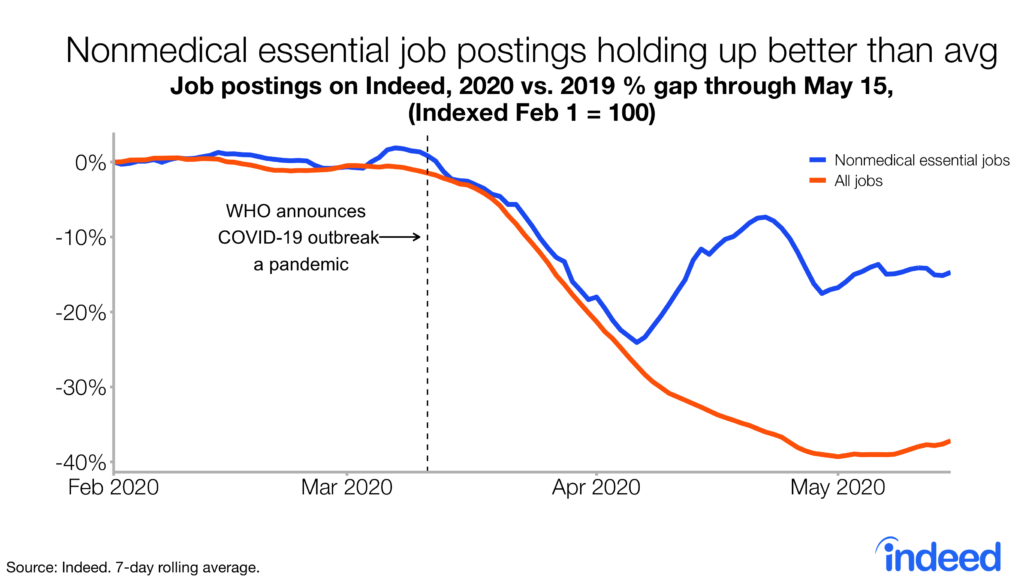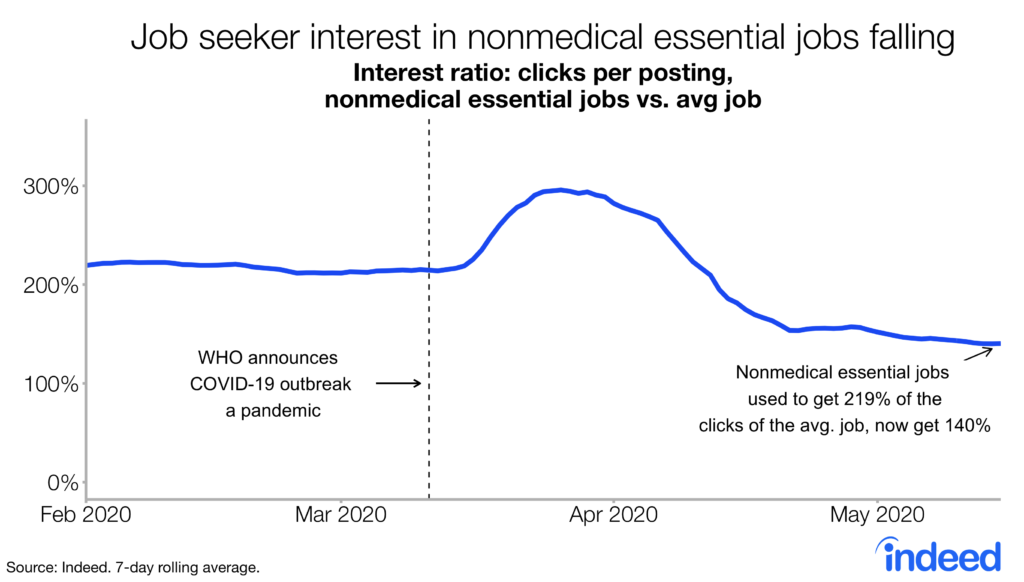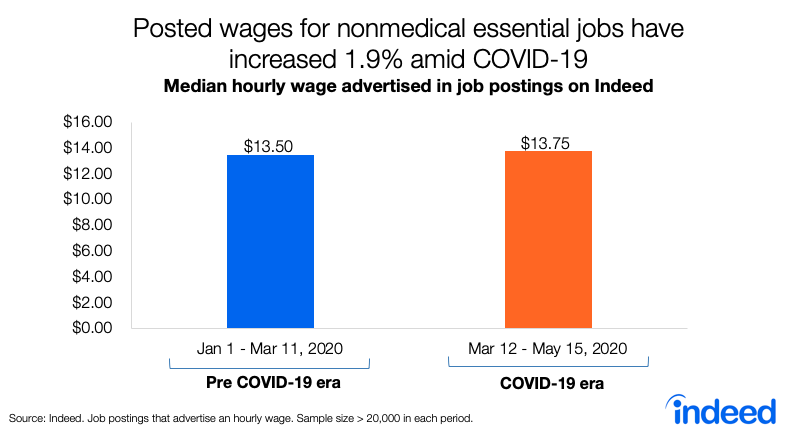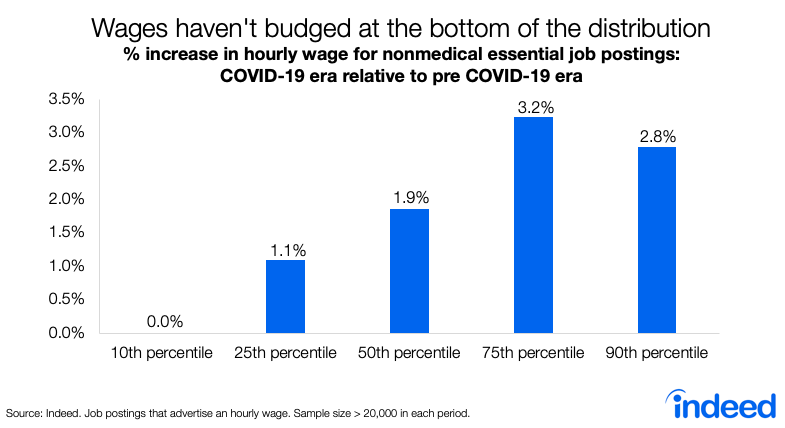Key points:
- Postings for nonmedical essential jobs, like grocery store worker and delivery driver, have fallen less than average during the coronavirus crisis.
- Job seekers are less interested in these positions than they were earlier this year, probably because of risk of infection.
- Takeaway for employers: Posted hourly wages for nonmedical essential jobs have risen, but not enough to overcome apparent job seeker worries about health risks.
As coronavirus wreaks havoc on the US, the economic pain is widespread. All job sectors have seen a slowdown in hiring, with employer demand relatively strongest in a small pocket of the economy — nonmedical essential jobs. There’s a critical need for workers who perform such tasks as stocking grocery store shelves or delivering takeout food to front doors. There’s also demand for workers who load trucks for delivery or clean and sanitize public spaces.
Of course, medical workers are also essential in a public health crisis. In this post though, we focus on nonmedical jobs that became mission critical nearly overnight. As most of the country continues to practice social distance, these jobs have become necessary to daily life — and employers know it.
Job postings fall less for nonmedical essential work

Employer demand for nonmedical essential workers during the COVID-19 outbreak is notable. Before the epidemic, postings for these jobs were growing at roughly the same rate as in 2019 and were on par with the trend in overall job postings. In early April though, about three weeks after the country began to shut down, nonmedical essential job postings and overall job postings began to diverge sharply. Through May 15, they were off only 14.7% from the comparable period in 2019, while overall job postings plunged 37.2%. This large gap reflects the fact that employer demand to fill these vital jobs remains substantial.
Job seeker interest has dwindled
Is employer demand matched by job seeker interest? To measure that, we compared average clicks per posting on nonmedical essential jobs with clicks on jobs overall. We found that, even as employers are actively working to fill these critical positions, job seekers have begun to shy away from them.
As the pandemic took hold, job seeker interest in nonmedical essential jobs rose at first, but then fell below levels before coronavirus. In February, before COVID-19 hit, these jobs were receiving an average of 219% more clicks than the average job. Through May 15 though, the gap dropped to 140%.This is a fall of 36% in a short timespan, a worrisome decline in job seeker interest. If employers can’t fill essential positions, packages will go undelivered and grocery store shelves unstocked.

Nonmedical essential jobs typically require workers to interact with the public and coworkers despite potential exposure to COVID-19. Presumably, the risk of infection has sapped job seeker interest.
Pay not rising fast enough to offset health worries

One way to encourage job seekers to consider nonmedical essential jobs despite the risks is to raise wages. And pay has gone up. Since before COVID-19, the median nonmedical essential job hourly wage has risen nearly 2%, a substantial jump for such a short time period.

Yet a close look shows these gains have gone primarily to higher-income workers. Indeed job postings at the 75th and 90th percentile of advertised wages have seen gains above 2.5% each since before COVID-19. By contrast, at the 25th percentile, the gains were just 1.1%. And jobs at the 10th percentile registered no hourly wage gains at all, a particular disappointment.
Advertised wages simply may not have risen enough to boost job seeker interest. The danger of infection has more than offset gains in pay. Given greater employer demand for workers to fill these jobs, it may be necessary to raise hourly pay further. Pay is typically job seekers’ top priority and more money may be needed in light of the risk workers now face.
Conclusion
Nonmedical essential workers — cleaners, delivery drivers, grocery store staff, and similar jobholders — are keeping society functioning. Employers are actively looking for workers to fill these positions. But job seeker interest has fallen 36% during the pandemic. To encourage job seekers to apply for these positions, employers may need to raise pay more than they have so far. The median hourly wage has only risen 1.9% during the crisis and most of those gains have gone to the top half of jobs ranked by advertised pay.
We celebrate workers who courageously perform essential jobs — those who keep us fed, clean our cities, deliver supplies. Boosting their pay would be a tangible way to show our gratitude.
Methodology
Nonmedical essential job postings are defined as those from a major grocery store chain, the loading and stocking job category, delivery-focused jobs like delivery driver, courier, and cleaning-focused jobs like cleaner and janitor.
Pay data are from job postings with hourly wages on Indeed between January 1 and May 15, 2020. During this period, 56% of nonmedical essential job postings with pay information specified an hourly wage rather than an annual salary or another rate. When a job posting specifies a range (e.g., $9.50-$10.50 an hour), we use the midpoint.
Using regression analysis, the increase in average posted wages for nonmedical essential workers over the period analysed is statistically significant and robust to controlling for compositional changes in nonmedical essential job postings, such as a shift toward more or less senior job titles.
To measure trends in job postings, we calculated the seven-day moving average of the number of job postings on Indeed. We indexed each day’s seven-day moving average to the start of that year (February 1, 2020 = 100 for 2020 data and so on) or another date if specified on the chart.
We report how the trend in job postings this year differs from postings last year in order to focus on recent changes in labor market conditions due to COVID-19. For example, if job postings increased 30% from February 1, 2019 to May 1, 2019, but only 20% from February 1, 2020 to May 1, 2020, then the index would have risen from 100 to 130 in 2019 and 100 to 120 in 2020. The year-to-date trend in job postings would therefore be down 7.7% on May 1, 2020, relative to 2019 (120 is 7.7% below 130) .
Information is based on publicly available information on the Indeed website, limited to the United States. It is not a projection of future events and includes both paid and unpaid job solicitations.






